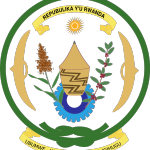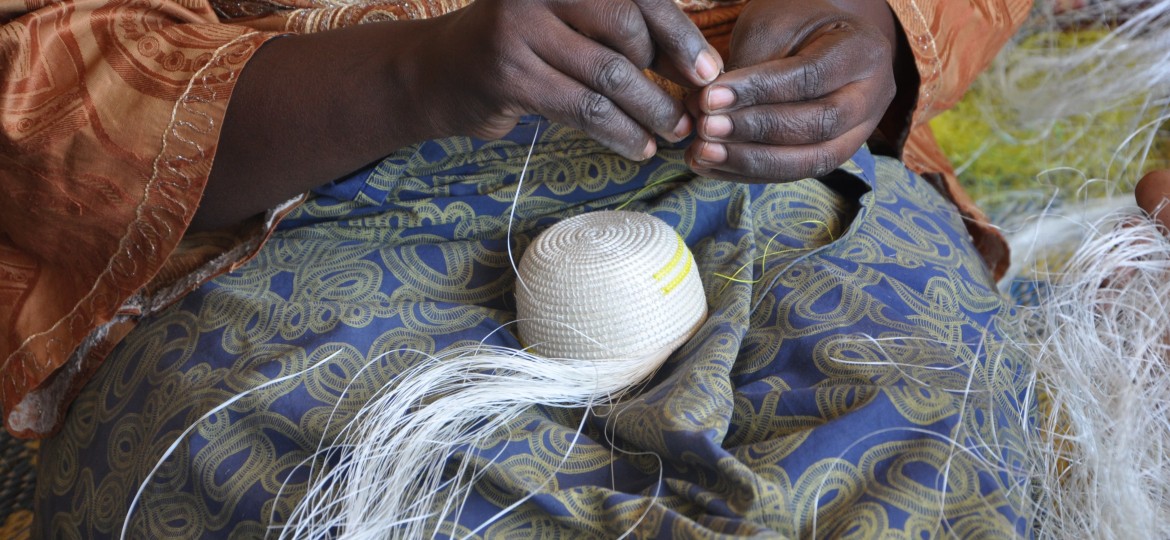Written by Dr Catia Gregoratti
The agaseke
The agaseke is a handcrafted basket which has been part of Rwandan cultural heritage for centuries. An attentive observer can also notice that the agaseke holds a central place in Rwanda’s coat of arms. Historically, basket making was considered as a practical and recreational activity reserved for women. Knowledge of weaving was passed down from mother to daughter as this was considered a pre-requisite for marriage and a talent associated with being a good housewife. Women taking “poorly woven” baskets to the marital home were considered either lazy or poorly trained.
 These cone-topped baskets are made with sisal, papyrus or banana fibers. Besides fibers and a needle, what is needed to assemble them are good eyes, dexterous hands as well as a great deal of patience. Depending on its size, completing a basket can take up to a week. Agaseke are used to store and carry food or precious objects but they also symbolise love, friendship and prosperity in the exchange of gifts during home visits or at weddings. Yet anything with a lid also conjures secrecy. Traditionally, a potent and deeply gendered secret was revealed at weddings when a prospective husband would lift the agaseke’s lid to find if his future wife was a virgin or not. If the basket contained a blood-stained cloth was only for the couple to know.
These cone-topped baskets are made with sisal, papyrus or banana fibers. Besides fibers and a needle, what is needed to assemble them are good eyes, dexterous hands as well as a great deal of patience. Depending on its size, completing a basket can take up to a week. Agaseke are used to store and carry food or precious objects but they also symbolise love, friendship and prosperity in the exchange of gifts during home visits or at weddings. Yet anything with a lid also conjures secrecy. Traditionally, a potent and deeply gendered secret was revealed at weddings when a prospective husband would lift the agaseke’s lid to find if his future wife was a virgin or not. If the basket contained a blood-stained cloth was only for the couple to know.

Photo by Catia Gregoratti
The making of a gendered trade
How baskets such as the agaseke became goods with a monetary value attached to them is a process often traced back to Belgian colonial rule in Congo and Ruanda-Urundi. As Ilaria Buscaglia and Shirley Randell’s research show, “female promotion” was used by colonial authorities as a powerful apparatus to civilise and domesticate “indigenous women”. Catholic nuns and missionaries were central to its day-to-day administration through a programme known as foyers sociaux (or social homes), where women would be taught how to become “real ladies of the house”. Knitting, dressmaking, cleaning, ironing, cooking are often documented as the main courses imparted in the foyers.
First-hand accounts from older basket weavers take us back to early 1970s, a time when missionaries and nuns appeared to play an increasingly important role in developing women’s basket weaving skills in convents or through village workshops. More than teaching women how to make more refined or durable baskets, white sisters and monks abetted the transition of basket weaving for primarily domestic use to basket weaving for commercial purposes, directly buying the baskets or setting up markets for their sale. The role of missionaries and nuns in blurring the boundaries between socially reproductive and productive work is certainly not unique to Rwanda. Maria Mies’s seminal study on the development of lace-making in Narsapur recounts a strikingly similar story, implicating Irish and Scottish nuns in the introduction of the idea that a domestic craft could earn women money, helping them and their families combat poverty.
Towards the end of the 1970s women because more autonomous in the production and sale of baskets. A cottage industry began to emerge when some of the more experienced weavers became intermediaries, sourcing baskets from the homes of rural weavers to then sell them in Rwanda’s capital city, Kigali. At around this time, there are also records of how weavers commenced to organise the production and sale of baskets through the establishment of weavers and artisans’ cooperatives.
The agaseke today
In the aftermath of the 1994 genocide the meaning of the agaseke becomes attached to a much wider state-building project premised on peace and development in which women came to symbolise healing and rebirth. Through the re-establishment and formation of new weavers’ groups and association, women found a way of passing time, heal from the traumas of genocide, confront ethnic differences, and earn some money to ensure their survival and those of their dependants. Weaving also became an important source of income for genocide suspects and inmates who leant how to weave while in prison and continued weaving once released. According to figures shared by Kigali City Council, a decade after the genocide the Rwandan government supported 300 cooperatives, particularly in rural areas, with women comprising 60 per cent of their members.
Today the agaseke has become more commonly known as the Peace Basket. Alongside making-up an important share of domestic handcraft production for tourists, to some, it has also come to represent Rwanda’s most important cultural export. The Peace Basket can be found and purchased in the shelves or in the on-line retail spaces of Macy’s and Wal-Mart but also in a myriad of smaller shops in the US, Germany, the UK, the Netherlands, France, Italy, Japan, Switzerland and Canada. Under the US African Growth and Opportunity Act (AGOA) and the EU Everything But Arms (EBA), Rwanda’s handcraft exports enjoy duty-free access to these huge markets.
Inclusive growth and women’s empowerment
“In Rwanda today, 52% of our population are women. Can you imagine getting 52% of the population out of the economy?…” President Paul Kagame
Dovetailing with a global discourse that proclaims the inclusion of women in the market as the missing component for strategies on inclusive growth, the development of the basket industry has been facilitated by conscious governmental efforts to stimulate growth through export diversification together with priority commitments to promote women’s empowerment and entrepreneurship. Rwandan government officials I interviewed in the course of field-research indicated that women’s work in cooperatives was understood as a first-step to reduce poverty, formalise informal work and instil an entrepreneurial mind-set. Women were often posited as a selfless subjectivity – one that sacrifices her earnings for the wellbeing of her family – but also as rational decision-makers with ambitions to become small business owners. These themes are evident in the video below, which reports on the sale of agaseke baskets in America through the US department store Macy’s.
In the context of women’s peace-time employment it is also important to note the prominent role played by more traditional as well as new development actors and alliances in advancing the development vision of the Rwandan government. A wide array of international organizations, national and international non-governmental organizations, social enterprises, foundations, business schools, celebrities, designers as well as business have channeled and intensified efforts, through various forms of support, to Rwandan women’s cooperatives and artisans. There is however a great deal of diversity in how women’s empowerment is conceived and practiced. While some empowerment programmes are primarily market-oriented, others teach women not only how to become savvy artisans but address illiteracy, reproductive health and gender relations in the household.
Entrepreneurialism, empowerment and the feminisation of survival
The World Bank’s 2008 report Doing Business: Women in Africa showcases a number of successful women entrepreneurs. Amongst these entrepreneurs we find Janet Nkubana one of the owners of Gahaya Links – the company that ensures that Peace Baskets, beaded jewelry and textile items handcrafted in Rwanda reach the shelves of giant retailers. Through Nkubana’s account we learn that artisans she employs now have an income, they can re-invest their income in their health and schooling of their children and that by virtue of working they have witnessed a decrease in domestic violence. Kate Bedford’s powerful analysis of the report invites several important questions:
Who exactly is the empowered woman in reports that celebrate entrepreneurial success? What are the tensions between business owners and employees, or even between traders and cooperatives? And what other stories can be heard when venturing beyond glossy reports and marketing material?

Photo by Catia Gregoratti
In Rwanda, I observed a big difference between the piece-rate wage paid to weavers and the baskets’ retail prices, but also a basket industry that is deeply stratified according to neoliberal standards of competitiveness. Higher than average piece-rates and steadier work can be found particularly in cooperatives that have learnt how meet the exacting quality, design and delivery specification of Northern buyers. For newer weavers’ cooperatives, which are also less likely to be connected to development actors and international markets, weaving and handcraft work is much more sporadic, comprising two or three days, while the remainder of the week is spent on care and subsistence work such as tending a small plot of land. For many of these women artisans, handcraft work is primarily driven by the necessity to survive and combine paid work with the invisible work of social reproduction. Piece-rates are hardly enough to cover the reproduction cost of the weavers.

Photo by Catia Gregoratti
Feminist political economists have argued that possibilities for women’s empowerment can emerge through associational life. Cooperatives are indeed one of such spaces. What they produce are not just goods for domestic, regional and world markets, but also affective bonds that can make everyday life a little more bearable, and at times, even joyful. Cooperatives can also function as vehicles to develop critical consciousness and lead to the politicisation of oppressive gender, class and ethnic relations. When and how this happens is however deeply contextual. In Rwanda, I have had the opportunity to see women’s cooperatives working ceaselessly to get a share of the handcraft market and cooperatives in which time is also reserved to gain critical consciousness and act upon gender oppression. How gender intersects with class and ethnicity is arguably the agaseke’s new secret, a secret that in the context of a deeply intrusive and authoritarian state can only be whispered.
Handicraft Resources
Dunaway, W. A. (ed) (2014) Gendered Commodity Chains – Seeing Women’s Work and Households in Global Production. Stanford: Stanford University Press.
Grimes, K. M. and Milgram B. L. (eds) (2000) Artisans and Cooperatives – Developing Alternative Trade for the Global Economy. Tucson: The University of Arizona Press.
Mies, M. (1982) The Lace Makers of Narsapur. Melbourne: Spinifex Press.
Bedford, K. (2009). “Doing Business with the Ladies: Gender, Legal Reform, and Entrepreneurship in the International Finance Corporation”, Labour, Capital and Society/TRAVAIL, capital et société, 42 (1&2), pp. 169-194
Mann, L. and Berry, M. (2016). “Understanding the Political Motivations that shape Rwanda’s Emergent Developmental State”, New Political Economy, 21 (1), pp. 119-144.
Roberts, A. (2015). “The Political Economy of “Transnational Business Feminism – Problematizing the Corporate-Led Gender Equality Agenda”, International Feminist Journal of Politics, 17 (2): 209-231.


